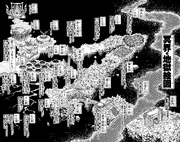
Inferno Illustration
The Inferno (冥界・地獄, Meikai Jigoku) is the realm of the dead where souls are placed after death; what area the souls reside in are determined by the Three Judges. It is the habitat of all Specters, including the god Hades (in classic myth, it is also the second residence of Hades's wife, Persephone).
The Meikai Underworld was created by Hades to forever punish humans for their crimes. No life is possible in the Underworld without the Eighth Sense (or special devices), as all things in the Underwrold normally fall under the control of Hades. Specters are unaffected, and may enter and leave at the discretion of Hades because they wear Sapuris, at least while Athena had not sealed their souls.
As depicted by Masami Kurumada, the Underworld is composed of eight prisons, with further subdivisions (the 7th prison is divided in three valleys, the 8th in ten pits, the 9th in four regions). All of the Prisons correspond to the nine Circles of Hell depicted in Dante Aligheri's Divine Comedy, which itself borrows heavily from Greek myths. In addition, it also contains the passage to the Elysian Fields, where only those chosen by the gods can go.
Between Mythology and Fiction
The Meikai corresponds to the Greco-Roman Underworld, Tartarus (called Hades as well after its king), where the souls of the dead descended. In contrast to the Underworld of classical mythology, in Saint Seiya, the kingdom of the dead presents itself as a completely gloomy and unhealthy realm, in addition to being the final resting place of wicked or regular souls (more in keeping with the Nordic Underworld, Hel or the Christian Hell). The design of the Surplices also reinforces this idea, except the armor of Hades, which, apart from the color, moreso resembles an angel, or an angel of death (especially the wings). The Saint Seiya Meikai term simply means "Underworld", unlike the Greek Underworld, which is broken down into the Fields of Asphodel (for neutral souls), Tartarus (for evil souls) and Elysion (for the souls of heroes and the righteous). The Meikai includes all that is shown in the manga, including Yomotsu Hirasaka, the scene of the battle between Dragon Shiryu and Cancer Deathmask.
The Pagan Underworld was divided in three regions:
- Tartarus ("Inferno" in Saint Seiya), where evil people were punished;
- Erebus ("Elysion" in Saint Seiya), where the Deities of Underworld lived;
- Elysion (not in Saint Seiya), resting place of wise souls.
Five rivers flowed in the Underworld:
- Acheron (same name in Saint Seiya), river that circled around the Underworld;
- Cocytus (same name in Saint Seiya), river created by the frozen teardrops of the damned in the Tartarus/"Inferno";
- Styx (same name in Saint Seiya), often described as a swamp;
- Flegethon (corresponding to the Hyperdimension in Saint Seiya), river of fire that separated the Erebus/"Elysion" from the other regions;
- Lethe (not in Saint Seiya), river that flowed in the Pagan Elysion, where the souls of wise departed were purified.
Nevertheless, Masami Kurumada's Meikai is modeled on the hell described by Dante Alighieri in his epic poem, the "Comedy". Dante's Inferno is divided into nine circles and Kurumada take ispiration from this division for the prisons in his manga. These are the nine Circles in Dante Alighieri's Hell:
- 1st Circle: Limbo of the Non-Baptized
- 2nd Circle: Lust
- 3rd Circle: Gluttony
- 4th Circle: Greed & Squander
- 5th Circle: Wrath & Laziness
- 6th Circle: Heresy
- 7th Circle: Violence, subdivided in 3 Rings
- 8th Circle: Fraud, subdivided in 7 Malebolge
- 9th Circle: Treachery, subdivided in 4 Rounds
According to Charon in Saint Seiya manga and Meikai OAV the Underworld (Meikai) is divided in 8 Prisons, 3 Valleys (corresponding to the Rings in the 7th Circle), 7 Malebolge and 4 Rounds.
Terminology
In the Saint Seiya Universe the Meikai (litt. "dark world". Hades himself is called Meioh, that means "Dark King") seemsto be the counterpart of the Tartarus in the classic mytholgy. The term tartarus is never used for the Hades's kingdom by Kurumada (in classic manga) or Teshirogi (in Lost Canvas manga), but only by Megumu Okada in Episode G manga for the place were the Titans and their people are sealed.
Internal Places
Underworld entrance
Gateways
In the series, two gateways in which Meikai can be accessed from Earth are depicted. The first one is at Yomotsu Hirasaka, by falling into the bottomless pit or through the underpassage behind Mandrake Fedor's prison building. The second one is at Heinstein Castle, where is another pit leading to Meikai.
Hell's Gate

Hell's Gate
Before reaching the river Acheron, there is a large gate that bears a message to those who enter the underworld. That message states that those entering should abandon all hope (the final line of the inscription on the Gates of Hell in Dante Alighieri's Divine Comedy). The large door is a stone archway supported by four columns, two on each side of the entrance, and on top of the arch is the grim warning to anyone who wants to enter the Underworld.
Acheron River
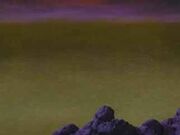
Acheron River
The river is a mossy green and surrounded by those who are destined for the Underworld. Souls cannot cross the river unless they pay for the ferryman to row them across. This area is guarded by the Spectre Acheron Charon. It is also called "Sanzu River" by Seiya (Sanzu is the Acheront equivalent in buddist mythology).
- The Acheron is the first river of the Underworld and, similar to the rivers Phlegethon and Cocytus, is considered by some authors a branch of the river Styx. In Dante's Divine Comedy, the river Acheron is at the edge of Hell, and as in classical Greek myth, is ferried by the boatman Charon.
First Prison: Hall of Judgement

First Prison
- Guardian Specter: Balron Lune
The First Prison (第一獄(プリゾン), dai ichi purizon) is the Hall of Judgement. The Hall is a huge palace with a long wide staircase, which ascends to a porch full of columns supporting a gable roof, all made of white stone. Beyond the columns is a large set of wooden double doors and sides with large windows bearing the same design as the door. This place is guarded by the Spectres Balron Lune and Griffon Minos, the latter of which is one of the Judges of the Dead.
- It shares its name with the First Circle of Hell in Dante's Divine Comedy, in which the pagans and unbaptized were placed. It is partially based on the Greek Fields of Asphodel, where the dead first await judgment to where their souls will ultimately end up. The dead cannot give any false accounts of themselves before the Judges; the deception is discovered immediately.
Dark Valley of the Wind

Second Prison
- Guardian Specter: unknown
The Dark Valley of the Wind (黒き疾風の谷 - kuroki shippū no tani), connects the First and the Second Underworld Prison . It is crossed by a bridge with two circular spaces on each end, connecting the two areas. The bridge is lined with simple stone columns in ruin.
- The damned here were once lovers in life and they suffer eternally in love and are thrashed by the black winds of this area. This area is based on the Second Circle of Hell in Dante's Divine Comedy; there the Lustful were punished by always being driven on by a hurricane without stopping to rest. The hurricane represents their lust, which in life was their main driving force to do evil, and which now drives them physically in death.
Second Prison: Gluttony
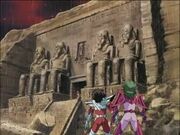
Third Prison
- Guardian Specter: Sphinx Pharaoh
The entrance of the second prison (第二獄(プリゾン), dai ni purizon) has the appearance of an Egyptian monument, surrounded by ruins, rocks and fallen columns. The entry itself is a high wall which is reached by a long narrow staircase. A doorway is seen between four huge statues of seated Pharaohs. Here are punished the gluttons, who are hit by freezing rain and devoured by the terrible hellhound Cerberus. This place is guarded by the Spectre Sphinx Pharaoh (fitting with the Egyptian theme of the Prison).
Flower Field

Flower Fields
The flower Filed (花畑 - hanabatake) is a place in the Underworld where beautiful flowers grow and where Eurydiuce is trapped after that Orphée broke his promess. It is a field of green grass and beautiful flowers of white, pink and yellow. This could be based on the Fields of Asphodel as well, as the fields were so named due to the abundance of asphodel flowers that grew there.
Third Prison: Greed & Squander
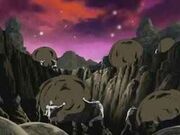
Fourth Prison
- Guardian Specter: Golem Rock [1]
The Third prison (第三獄(プリゾン), dai san purizon) is found by traveling a dirt road, which is flanked by two high walls of rock. The greedy and wasteful are punished in this prison, where they roll heavy stones uphill eternally for their sins; the rocks will always inevitably roll back down again (similar to the fate of the mythic king Sisyphus). This place is guarded by the Spectres Golem Rock and Troll Ivan .
Fourth Prison: Anger & Laziness
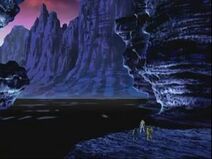
Fifth Prison
- Guardian Specter: Lycaon Phlegyas
The Fourth Prison, the Swamp of Darkness, is in reality a large valley covered by dark mountains and bathed by the waters. In this prison are punished those who suffer from extreme rage and despair. This place is guarded by the Spectre Lycaon Phlegyas.
The Swamp of Darkness in this Prison is based on the river Styx in Dante's Comedy, inspired by the classical mythology river of the same name.
Fifth Prison: Heresy
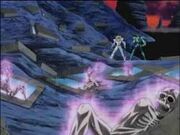
Fifth Prison
- Guardian Specter: Deadly Beetle Stand
- Walls of the City of Dis
In Dante's Comedy, these walls separate the punishments for letting go to the instincts (outer circles/prisons) from the punishments for being evil on purpose (this and following circles/prisons).
- The Fifth Prison
The proper Fifth Prison is beyond the Walls of Dis. It is a land of small mountains of rock and covered with darkened tombs made of stone blocks, where the heretics burn forever in the fiery tombs.
- Labyrinth of the Minotaur
After the flaming tombs is the Labyrinth of the Minotaur, a knotted huge field of stone walls so confusing and intricate no one can find the way out. The Labyrinth entrance is guarded by the Spectre Deadly Beetle Stand.
Sixth Prison: Violence
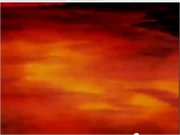
Sixth Prison
- Guardian Specter: unknown
The sixth prison (第六獄(プリゾン), dai roku purizon) is described in the Meikai map of Masami Kurumada's manga and it's divided in three valleys. The only valley showed in the manga is the first, when Balron Lune judges Seiya in the First Prison and tries to send him here as a punishment for his sins.
- The structure is the same of the Seventh Circle in Dante "Comedy".
- First Valley (一の谷, ichi no tani)
Those who have spent their lives to show violence towards others are thrown into a pond infernal blood.
- Second Valley (二の谷, ni no tani)
Suicides in this hellish land forest.
- Third Valley (三の谷, san no tani)
Those who are intoxicated unhealthy pleasures are thrown into a fiery infernal desert.
Great Waterfall Tears of Blood

Magnolia tree of the Underworld
The sixth prison ends with the great waterfall of blood, which is fed by the tears of all the deceased in the underworld (like the river Cocytus in Comedy). This large waterfall falls from the Sixth Prison to the Seventh Prison. At the top of the waterfall is the only tree in the underworld, whose fruits are totally opposed to the minerals that make the Surplices of the Specters.
In The Lost Canvas, Pegasus Tenma and Virgo Asmita take the fruits of this magnolia tree (mokurenji is Japanese for magnolia tree) and use them to make the rosary of 108 beads, where the souls of the Specters are sealed to prevent their resurrection.
Seventh Prison: Fraud
- Guardian Specter: unknown
The seventh prison (第七獄(プリゾン), dai nana purizo) is based on "Comedy" 's Eigth Circle, and like it (according to Kurumada's Meikai Map on volume 24) is divided in seven Malebolges. This prison appears only in Saint Seiya Lost Canvas as a desert with seven pits (the malebolges), because the exit of the secret passage that links the Meikai and Yomutsu Hirasaka is near this prison. The only Maleboge full showed is the fifth
- In this prison lies a bed of ferruginous colored stone. At the center of the prison opens a deep chasm, an immense well. The space between the entrance and the well is nearly round and is divided into ten Bolge, or pits.
Atavaka Residence
- Guardian Specter: Atavaka
This place appaears only in the Lost Canvas Virgo Anecdotes, and is the residence of the Specter Atavaka: the only that enjoys a special position among the 108 Demonic Stars of Hades' Army, and thus he is not subjected to Pandora's authority.
This place is similar to a buddisth temple. On the inside walls there are many mandalas with the faces of the people whose souls were devoured by Atavaka to increase his power.
- The exact location of this place is ambiguous.
Eighth Prison: Treachery

Nineth Prison
- Guardian Specter: unknown (the only named spectre that appears in this Prison is Harpy Valentine).
Also known as Cocytus, this part of the Underworld is a vast plain of snow and icy winds, which punish the damned who were traitors and those who conspired against the gods in life.It is the area where the Temples of the Three Judges of the Underworld are located, as well as the palace of Hades himself.
In Dante's Divine Comedy, Hades replaces Satan in his location in Hell, although unlike Satan, Hades is not physically imprisoned there. Hades' surplice has six wings: this is based on Dante's Comedy, where the Cocytus is frozen because of the wind generated by the six wings of Satan.
First Sphere: Caina
Caina is the first field in the frozen hell of Cocytos, and in Dante's work, it is the place of punishment for people who betrayed their family (named after the Biblical Cain, the first murderer, who killed his brother Abel out of jealousy). This temple belongs to the Spectre Wyvern Rhadamanthys, one of the Three Judges. It is a temple or mansion, possibly the home of the Spectre; a quadrangular building with four columns rounded at each end, and small steps around the entire structure. Both columns as the center of the building have domes adorned with statues of wyverns, the legendary creature on which is based Rhadamanthys's Surplice.
Second Sphere: Antenora
Antenora is the second region of ice in the Underworld, and in Dante's narrative is the place of punishment for people who betrayed their country (named after the mythical Antenor, a noble who betrayed Troy to the Greek army during the Trojan War by opening the city gates). This temple belongs to the Spectre Garuda Aiacos, another Judge of the Underworld. The temple has a polygonal base on which rises a circular building, whose circumference has columns interspersed by two walls, holding a broad and flat roof which emerges over columns arranged in circles, leaving a roof again but this time holding the figure of Garuda, the animal in which is based the Surplice of this Judge.
Third Sphere: Ptolemeia
Ptolemeia is the third region of Cocytos, where the souls of those who betrayed guests are punished (named for Ptolemy, a governor of Jericho who invited his in-laws to a feast, and then murdered them). The Temple here belongs to the Spectre Griffon Minos, the final Judge of Hell. The temple sits atop a high stone base of which is accessed via stairs. Its sides have two statues of cranes with their wings open. The building is surrounded by columns supporting the roof, which in its central part has gabled sides and is particularly smooth.
Fourth Sphere: Judecca
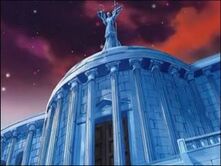
Judecca
Judecca is the last of the regions of Cocytos, and lies at the heart of the Underworld. In Dante's Divine Comedy, the region is named after Judas Iscariot, the legendary betrayer of Jesus Christ in Christianity, and is the resting place of those who betrayed benefactors, leaders and the gods. A palace at the center serves as residence to Hades, god of the Underworld, and Pandora, Hades's sister and commander of the army of Spectres. The palace is a building of a god in the purest Greek style. It is a central circular structure and the sides consist of two homers structures that form a single building. The entire building is surrounded by tall columns puffs, most of them stone walls covering the building. A huge wooden door stands at the center of the temple, leading to the chambers of the Lord of the underworld. Inside a large room at the bottom is a large and high stairway to the throne of Hades; behind it is a curtain covering the Wailing Wall, the entrance to the Elysian Fields or Elysium (a separate, peaceful paradise reserved for the gods and their protégés, as well as the souls of the good). The Wailing Wall itself is a huge wall made of dark colored rock carved in high relief with the faces of two winged deities, possibly the twin gods Hypnos and Thanatos, who inhabit the Elysian Fields. Also within Elysium lies the original body of Hades, which in mythological age was forced into dormancy after suffering a wound by the Pegasus Saint.
Gallery
Trivia
- Hades states that with his death that Elysion and the Underworld he made would disappear, however by Saint Seiya Omega the Underworld seems to be in working condition again as seen by the efforts of Cancer Schiller, begging the question whether Hades himself has also reformed.
Appearances
References
- ↑ Troll Ivan is also listed as second guardian in the Character Data in Saint Seiya Volume 28, although each prison should have one guardian only.
| Locations | ||
|---|---|---|
| Andromeda Island • Asgard • Atlantis • Death Queen Island • Jamir • Rozan • Sanctuary • Underworld | ||

